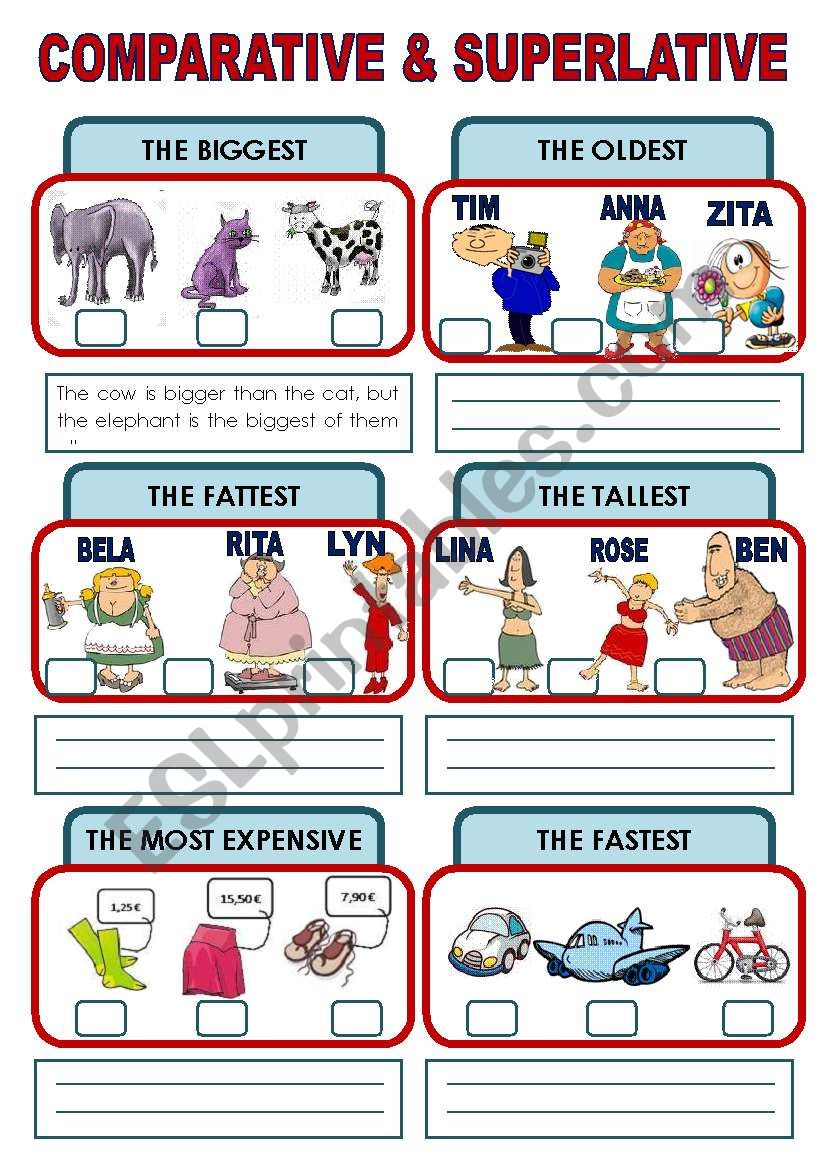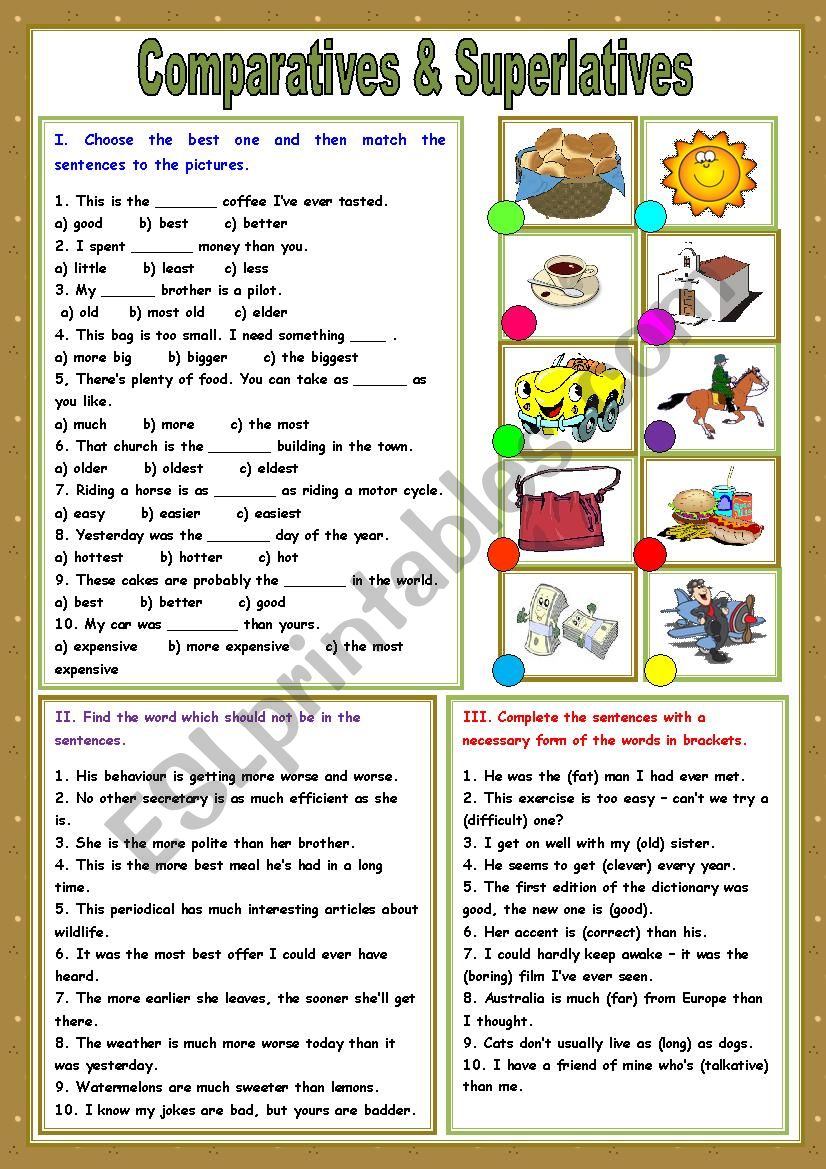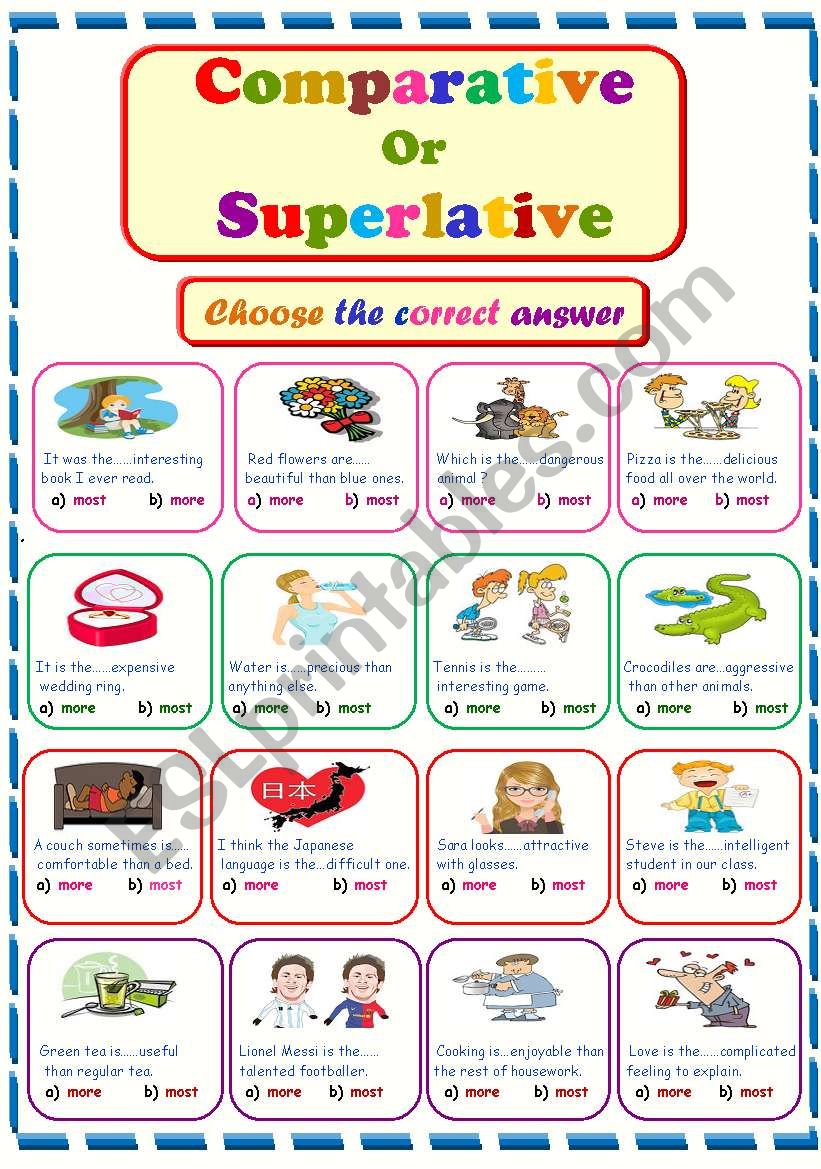
Mastering Degrees: The Indispensable Role of Comparative and Superlative for ESL Worksheets
English language proficiency hinges not just on vocabulary and basic sentence structure, but also on the subtle nuances of expressing degree and comparison. For English as a Second Language (ESL) learners, mastering comparative and superlative forms of adjectives and adverbs is a crucial step towards achieving fluency and natural communication. These grammatical structures allow speakers to articulate differences, preferences, and extremes – from stating that one object is "bigger" than another, to declaring something the "most beautiful" in the world. However, the rules governing their formation and usage can be complex, involving syllable counts, irregular forms, and contextual application. This is where well-designed comparative and superlative for ESL worksheets become invaluable, providing structured practice, reinforcement, and a scaffolded approach to learning these essential grammatical tools.
This article delves into the significance of comparative and superlative forms, explores the pedagogical advantages of utilizing worksheets, outlines various types of effective exercises, and discusses best practices for integrating them into the ESL curriculum.
Understanding the Core Concepts: Comparatives and Superlatives

Before diving into the worksheets, a brief review of the grammar is essential.

1. Comparatives:

Comparatives are used to compare two things, people, or groups. They indicate that one item has more or less of a certain quality than another.

- Formation Rules:
- One-syllable adjectives/adverbs: Add "-er" to the end. (e.g., tall → taller, fast → faster)
- Two-syllable adjectives ending in "-y": Change "-y" to "-ier". (e.g., happy → happier, easy → easier)
- Adjectives/adverbs with two or more syllables (not ending in "-y"): Use "more" before the adjective/adverb. (e.g., beautiful → more beautiful, interesting → more interesting)
- Irregular forms: Some common adjectives and adverbs have irregular comparative forms that must be memorized. (e.g., good → better, bad → worse, far → farther/further)

- Structure: Adjective/Adverb + "-er" / "more" + than + Noun/Pronoun.
- Example: "My car is faster than yours." "She is more intelligent than her brother."




2. Superlatives:
Superlatives are used to compare three or more things, people, or groups, indicating which one has the most or least of a certain quality. They signify the highest or lowest degree.
- Formation Rules:
- One-syllable adjectives/adverbs: Add "-est" to the end. (e.g., tall → tallest, fast → fastest)
- Two-syllable adjectives ending in "-y": Change "-y" to "-iest". (e.g., happy → happiest, easy → easiest)
- Adjectives/adverbs with two or more syllables (not ending in "-y"): Use "most" before the adjective/adverb. (e.g., beautiful → most beautiful, interesting → most interesting)
- Irregular forms: Corresponding irregular superlative forms exist. (e.g., good → best, bad → worst, far → farthest/furthest)
- Structure: The + Adjective/Adverb + "-est" / "most" + Noun/Pronoun (optional context).
- Example: "He is the tallest student in the class." "This is the most interesting book I’ve ever read."
Why Worksheets Are Essential for ESL Learners
For ESL learners, especially beginners to intermediate students, the journey from understanding a grammar rule to confidently applying it requires extensive practice. This is where comparative and superlative for ESL worksheets prove indispensable for several reasons:
- Structured Practice: Worksheets provide a controlled environment for learners to apply rules without the pressure of spontaneous conversation. They break down complex grammar into manageable chunks.
- Repetition and Reinforcement: Repetitive exercises help solidify the formation rules and irregular forms in the learners’ minds, moving knowledge from short-term to long-term memory.
- Targeted Skill Development: Worksheets can focus specifically on common errors, such as confusing "-er" with "more," or neglecting to use "the" before superlatives.
- Independent Learning: They allow students to practice at their own pace, either in class or as homework, fostering autonomy and self-assessment.
- Visual and Kinesthetic Learning: The act of writing, filling in blanks, and matching can cater to different learning styles, making the abstract rules more concrete.
- Assessment Tool: Teachers can use worksheets to gauge student understanding, identify areas of weakness, and tailor future lessons accordingly.
Designing Effective Comparative and Superlative for ESL Worksheets
The effectiveness of a worksheet isn’t just about having questions; it’s about thoughtful design and pedagogical intent. Here are key considerations when creating or selecting comparative and superlative for ESL worksheets:
- Clarity and Simplicity: Instructions should be unambiguous and easy to understand, even for lower-level learners. Use clear examples.
- Scaffolding: Start with simpler tasks (e.g., forming comparatives/superlatives from a list of adjectives) and gradually progress to more complex ones (e.g., writing sentences, comparing multiple items).
- Contextualization: Grammar should not be taught in isolation. Embed exercises in meaningful, relatable contexts (e.g., comparing family members, describing different cities, rating movies). This helps students see the practical application.
- Variety of Exercise Types: Avoid monotony. Mix and match different activity formats to keep learners engaged.
- Visual Aids: Incorporate pictures, charts, or diagrams to make comparisons more concrete, especially for visual learners or younger students.
- Answer Keys: For self-study or peer-correction, a clear answer key is invaluable. It provides immediate feedback and allows learners to correct their own mistakes.
- Fun and Engagement: Whenever possible, infuse a element of fun. Puzzles, riddles, or comparisons of popular culture items can make learning enjoyable.
Types of Comparative and Superlative for ESL Worksheets
A diverse range of activities can be incorporated into comparative and superlative for ESL worksheets to cater to different learning objectives and student levels:
-
Basic Formation Drills:
- Fill-in-the-Blanks: Provide an adjective/adverb and ask students to write its comparative and superlative forms.
- Example: (old) → ____ (older) → ____ (oldest)
- Example: (good) → ____ (better) → ____ (best)
- Categorization: Students sort adjectives into columns based on their formation rules (e.g., add "-er," add "more," irregular).
- Fill-in-the-Blanks: Provide an adjective/adverb and ask students to write its comparative and superlative forms.
-
Sentence Completion:
- Comparative Sentences: Provide a sentence with a blank and an adjective, and students complete it using the comparative form and "than."
- Example: My sister is ____ (tall) than me.
- Superlative Sentences: Provide a sentence with a blank and an adjective, and students complete it using the superlative form and "the."
- Example: Mount Everest is ____ (high) mountain in the world.
- Comparative Sentences: Provide a sentence with a blank and an adjective, and students complete it using the comparative form and "than."
-
Error Correction:
- Students identify and correct mistakes in sentences that misuse comparative or superlative forms. This is excellent for developing critical grammar awareness.
- Example: "She is more taller than her brother." → "She is taller than her brother."
- Example: "He is the most fast runner." → "He is the fastest runner."
- Students identify and correct mistakes in sentences that misuse comparative or superlative forms. This is excellent for developing critical grammar awareness.
-
Picture-Based Activities:
- Comparing Objects/People: Provide two or three pictures of similar items (e.g., different sized apples, different speed cars) and ask students to write comparative or superlative sentences about them.
- "Find the Difference": Students compare two slightly different pictures using comparative adjectives.
-
Information Gap / Question & Answer:
- Students work in pairs. Each has partial information and must ask their partner questions using comparatives/superlatives to complete their chart or diagram.
- Interview Activities: Students interview classmates using questions like "Who is the most adventurous person in our class?" or "What’s the most difficult subject for you?"
-
Creative Writing Prompts:
- "My Ideal City/Country": Students describe their ideal place, using superlatives to highlight its best features.
- "A Day at the Zoo": Students compare different animals using comparatives (e.g., "The elephant is bigger than the lion").
- "The Best/Worst Experience": Students write a short paragraph about their best or worst experience, naturally incorporating superlative forms.
-
Debate/Discussion Prompts:
- While not strictly a worksheet, a worksheet can provide the framework for a comparative/superlative debate (e.g., "Which is better: city life or country life? Use comparatives to explain your choice.").
Integrating Worksheets into the ESL Classroom
Worksheets should not be used in isolation but integrated seamlessly into a broader lesson plan.
- Pre-teaching: Introduce the grammar rules, provide clear explanations, and demonstrate usage before distributing worksheets.
- Guided Practice: Begin by completing the first few questions together as a class, clarifying any doubts.
- Individual or Pair Work: Allow students to work independently or in pairs, fostering collaboration and peer learning.
- Review and Feedback: Go over the answers as a class, encouraging students to explain their choices. Address common errors and provide constructive feedback.
- Homework: Assign worksheets for homework to reinforce learning outside the classroom.
- Assessment: Use worksheets for formative assessment, checking for understanding before moving on to new topics.
- Differentiated Instruction: Provide varied worksheets for different proficiency levels within the same class. Simpler ones for struggling students, more complex or creative tasks for advanced learners.
Common Challenges and Solutions
Even with excellent comparative and superlative for ESL worksheets, learners might face challenges:
- Over-reliance on Rules: Some students might mechanically apply rules without understanding the meaning. Solution: Emphasize context and practical application through speaking activities.
- Irregular Forms: These require rote memorization. Solution: Create flashcards, mnemonic devices, or dedicated irregular-form matching exercises.
- Contextual Confusion: Students might struggle to decide whether to use a comparative or superlative. Solution: Provide clear scenarios and opportunities for discussion, asking "Are you comparing two things or more than two?"
- Boredom: Repetitive drills can be tedious. Solution: Vary worksheet types, incorporate games, and relate content to student interests.
- Lack of Speaking Practice: Worksheets are primarily written. Solution: Follow up worksheet activities with communicative tasks where students use comparatives and superlatives orally.
Conclusion
Mastering comparative and superlative forms is a cornerstone of effective English communication, allowing learners to express a wide spectrum of ideas with precision. While the grammar can be intricate, the strategic use of comparative and superlative for ESL worksheets provides a robust framework for practice, reinforcement, and ultimately, mastery. By designing engaging, contextualized, and varied worksheets, and by thoughtfully integrating them into dynamic lesson plans, educators can equip ESL learners with the confidence and grammatical accuracy needed to navigate comparisons and express degrees in both written and spoken English. These worksheets are not just pages of exercises; they are indispensable tools on the path to fluency.
